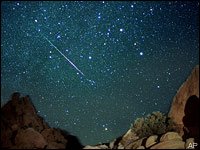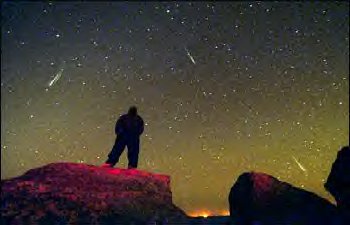

 |
The Perseids are bits of space debris that were shed by Comet Swift-Tuttle in past centuries and remain traveling more or less along the comet's 130-year orbit around the sun. The particles range in size from sand grains to pebbles, and they have the consistency of dry dirt. As it orbits the sun, Earth passes through this thin "river of rubble" every year in mid-August. Each meteoroid rips into our upper atmosphere at 37 miles per second, creating an incandescent trail of shocked, ionized air. This hot trail, not the tiny meteoroid itself, is what you see.
The Perseids are one of the two strongest, most dependable annual meteor showers (the Geminids of December are the other; here's a list of all the best ones). The grand Perseid displays of the 1990s seem to be well and truly over, so this year under a dark sky you might see "only" 60 to 90 Perseids per hour between midnight and dawn. Light pollution cuts down the numbers, but the most spectacular streakers always shine through.
 |
These meteors can flash into view anywhere in your sky, but all of them (if you trace their paths back far enough) appear to diverge from a spot in northern Perseus near Cassiopeia. This is the shower's radiant point. The radiant is an effect of perspective; the particles are actually traveling in parallel through space. Meteors you see near the radiant look slow and short because they're coming at you almost head-on. Those far from the radiant appear longer and faster, because you see them broadside.
In early evening the radiant is low in the north-northeast, so Perseids graze into the atmosphere over your part of the world at a low angle and you don't see very many. As the night grows late, the radiant rises higher in the northeast, the meteors arrive more nearly straight down, so you see them in greater numbers. By the first glimmer of dawn the radiant is quite high, about 60° up for observers at mid-northern latitudes.
How to Watch
Find a spot with an open sky view and no glary lights. Bundle up in blankets or a sleeping bag, both for warmth and mosquito shielding (and don't forget the repellent). Lie back, gaze into the stars, and be patient. The direction to watch is wherever your sky is darkest, usually straight up. That's all there is to it.
And don't forget that the shower lasts more than one night. Rates are about a quarter to half the peak for one or two nights before and after. In fact, the shower lasts about two weeks and stragglers have been recorded as late as August 24th.
Also, not all meteors you'll see are Perseids! In addition to occasional random, sporadic meteors, the weaker Delta Aquarid shower is also active during Perseid season. The Delta Aquarids are slower, often yellower and fly away from a radiant in eastern Aquarius.